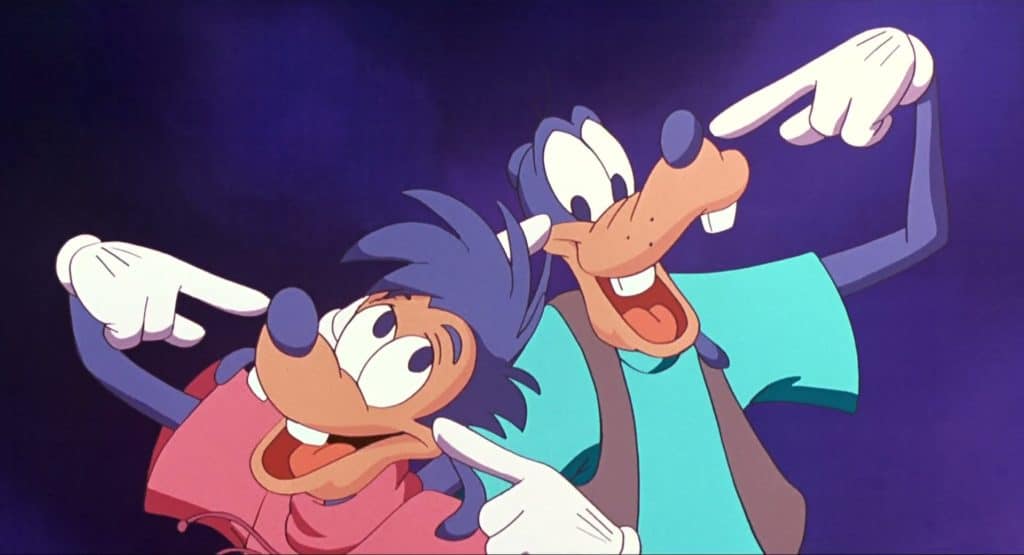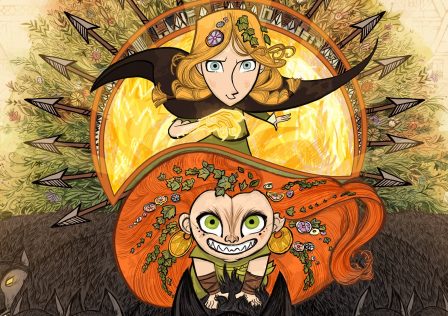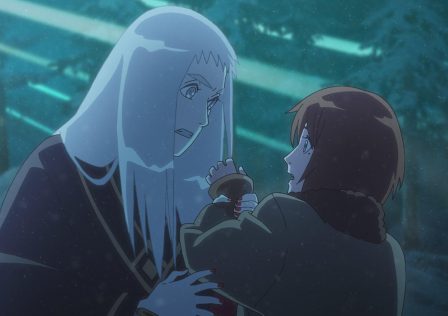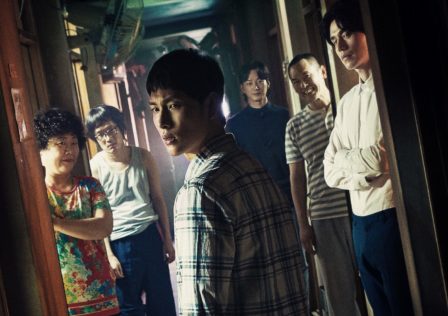A Goofy Movie has one of the finest opening sequences in any theatrically-released Disney movie. Hear me out.
It starts with Maximillian Goof (Jason Marsden), the son of the Goofy (Bill Farmer), frolicking in an Elysian plane with his high school crush Roxanne (Kellie Martin). It is as wet a dream as a Disney film could get. But as Max leans in to kiss Roxanne, the sky darkens and she recoils back in horror.
Now it’s getting Kafkaesque. Max is transforming – his fingers grow longer, his toes shooting out of his shoes as his limbs and face elongate. It looks painful. The film made sure to show Roxanne backing off in horror as it reveals that Max has turned into his father. He clutches his throat as he horrifically bleats out the iconic “Ah hyuk!” (complete with a timely lightning flash).
It’s probably too late to apologise for ruining childhoods, huh?
It’s pretty intense, largely because it also serves as a spoof of werewolf transformations. Beyond that, however, it’s an engaging way to set up Max’s conflict for the entire film – his deep affection for Roxanne, and his fears that he is turning into his dad — too dorky to date.
The scene also effectively captures a strange, rather innate fear – that sons, in one way or another, can never escape their fathers. It’s in our DNA, after all.
This Dream Intro is just one of the many reasons that A Goofy Movie is such an important Disney film, to me and to a whole lot of people. The 1995 feature, a spin-off of the Disney Afternoon series Goof Troop, is perhaps Disney’s greatest cult hit. The theatrical release was initially a flop, but its release on home video exploded into a sleeper success. It may not have the legacy of The Lion King, but judging by the packed hall and two-minute standing ovation during its 20th anniversary celebration in the 2015 D23 Expo, A Goofy Movie is clearly dear to the hearts of many.
Ironic, in that it’s not even produced by Walt Disney Feature Animation. A Goofy Movie was primarily made with help by Disney Animation outposts in Paris and Australia, assisted by outside studios in Spain and Canada. It had a modest budget and little-to-no marketing. As veteran Disney producer, Don Hahn remembered it: “It wasn’t even a B movie. It was a C movie.”
Yet it’s a movie that is as resilient and indestructible as Goofy himself. Director Kevin Lima (who would go on to direct Disney’s Tarzan and Enchanted) credits its lastingness to the movie’s surprising emotional heft.
“I think at the core of anything that lasts is something that’s truthful,” he said in an interview with Variety.
“And at some point or another, we all feel this way about our parents. We want to disconnect with our parents, only to realise years later that they were okay. They were doing their best. They loved me.”
Somehow it’s truthful enough that it transcended cultures and affected a Southeast Asian teenager – and eventual man-child – like me.
A Goofy Movie is fueled by Americana (as most Hollywood road movies do), and argues parenting in the context of America. As a child, the film felt distant and uninteresting to me – at least when it doesn’t concern Goofy suffering cartoonish bodily harm. Yet it’s a movie I’ve come to appreciate as I grow older.
I suspect it’s because my relationship with my late father changed as we both aged, and A Goofy Movie somehow allows me to contextualise it. The film may be steeped with American values, and my father and I are nowhere close to Max and Goofy (we’re more Atreus and Kratos), yet a chord was struck.
I suppose one can argue in terms of relativity. My father straddled the line between Asian parenting and increasingly globalised ideals. He may be strict, but he engages my brother and I with activities like sports and card games. He’d talk to me about movie recommendations, even though I’d struggle to discuss movies beyond just what’s good and what isn’t. He may be emotionally distant sometimes (barring anger or frustration at my misbehaviours), but never too dismissive of our feelings.
Some days, I wonder if those moments of him forcing me to help him with repairs and random projects (we’ve done things from building dog houses with chicken wire and metal frames to attempting an ambitious DIY fencing project) were attempts at bonding. Most times they feel more like prolonged silent tortures, with him wrestling with his growing aggravation at my gross incompetence while I lament the loss of free time. At those moments, I’m not different from Max in A Goofy Movie — resistive and resentful.
As I grew and absorbed more Western values, our differences expanded into a communication divide. From there on, it’s hard not to view a film like A Goofy Movie without finding a semblance of relatability.
Yet a relatable movie doesn’t make for a memorable or cherished one. A Goofy Movie feels important, and I peg this down to its storytelling. It may be a C-movie, but it scores an A in craft.
Let’s summarise the movie first. At school after the dream sequence, Max – with the help of his pals P.J and Bobby (Rob Paulsen and an uncredited Pauly Shore) – crashes the pre-summer-holiday school assembly by performing as Powerline, also known as “the biggest rock star on the planet”. It was largely to gain the attention of Roxanne, but Max gets into trouble with the principal.
Fearing growing delinquency from his son, Goofy makes the decision to whisk Max onto a road trip that past Goofs have all undertaken. Max is instantly reluctant to go; he has just scored a date with Roxanne. Panicking, he lies to Roxanne about taking a trip to the Powerline concert in California – and now has to manipulate his dad to change their travelling plans instead.
What follows is a cross-country road trip, in which the father and son stop at a possum-themed theme park; get terrorised by Bigfoot; go through a bonding montage; and, eventually, reconnect over a life-and-death situation before capping the film off with learned lessons about honest communication. Gluing all of this together are incredibly catchy musical numbers, some inspired animation, and an emotional layer that you might not expect from a movie starring Goofy.
I credit the emotional effectiveness to the movie’s willingness (and finesse) to go from silly to serious. Most fans would recognise the hot tub scene three-quarters into the movie, in which Goofy has a conversation with Pete, P.J’s father, about parenting styles and trust. Pete has overheard that Max has altered their route so that they’ll end up going to Powerline’s concert, which Goofy vehemently brushes off, his trust in Max resolute. There’s no comedy in this sequence. When Goofy finally learns the truth, the devastation in his face is heart-breaking.
These scenes are surprising in A Goofy Movie, not just because we expect it to be constantly goofy, but also because it exists in a movie that is only 78 minutes long. The tight scripting and storyboarding meant that A Goofy Movie can afford to have scenes that furthers characterisation rather than plot. For instance, the possum theme park sequence puts Max in such an embarrassing situation in a place that is almost nightmarish that we can’t help but sympathise with his plight, even if he is acting bratty against a father that only wishes well. Later, when the duo are trapped in their car by Bigfoot, they get to share a heartfelt moment over a can of “Hi Dad” soup – establishing that there was a closeness between them once.
Max and Goofy’s relationship is also shown through a combination of solid writing and neat little details. In one sequence towards the climax, when their car careens downhill while they both have to attempt to enter it from the outside, they bickered and blame-gamed while assisting one another — their synergy betraying the toxic words they are spewing.
Their dynamic relationship is contrasted with another father-son duo in the movie – Pete and P.J, who have very unequal standing with one another. Pete demands respect from his son without affording any, which differs Goofy’s freer approach. Parents would certainly have a debate over which parenting style is appropriate, but the movie frames Goofy’s as right – not without first fixing communication issues, of course.
Then there’s Goofy’s “Perfect Cast”, a fishing technique involving a complex set of moves that he first tries to teach Max before their Bigfoot encounter. Max wasn’t receptive to the lesson, but at the end of the film, he has to perform the Cast in order to save Goofy from a waterfall. It’s a nice Chekhov’s setup that reveals a few things. For one, it shows that Max is a lot more attentive towards his father than initially let on; but more significantly, it allows his character arc to go full circle. Rather than reject and fear his lineage, Max has come to accept it.
This is taken a step further when the duo crashes Powerline’s concert, and they both performed the Perfect Cast on stage, much to the delight of Powerline. The song in that sequence is titled “I2I“ (Eye-to-Eye) — Goofy and son have finally come to terms with each other. The movie even ensures that they land a back-to-back pose on stage that is reminiscent of the Goof Troop intro.
Director Kevin Lima says that the movie works because of its truthful core, but I think that is selling short the attention and craft that he and his team brought to a movie that was relegated to the sidelines. It’s a potent mixture that achieves what all good parent-child movies do – allowing the audience to empathise, and sympathise, with each party.
If anything, A Goofy Movie allows me to understand my father better. Like Max, I too have been whisked into impromptu road trips – ones that typically go by in silence or partially interrupted with arguments. I, too, have been forced to check out dodgy roadside attractions, and placed in overly embarrassing situations in public by well-meaning parents.
These are all universal problems. As Neil Gaiman wrote: “Of course, everyone’s parents are embarrassing. It goes with the territory. The nature of parents is to embarrass merely by existing, just as it is the nature of children of a certain age to cringe with embarrassment, shame, and mortification should their parents so much as speak to them on the street.”
But A Goofy Movie helps me see that my late father was one who tried. He may not have known how, but he made attempts to connect. He was doing his best.
At the end of it, A Goofy Movie is a fantasy – one where a parent and child can open up and find that they are forever changed for the better. For some, this doesn’t happen. For some, opening up just leads to more bitterness. For some, there’s no longer a chance to do so.
But it’s a good sort of fantasy.
Also published on Medium.

makes it a life goal to annoy everyone with random Disney trivia. When he’s not staring at a screen or holding a controller of some sort, he is thinking about curry noodles. Like right now.



